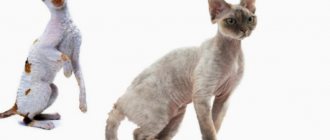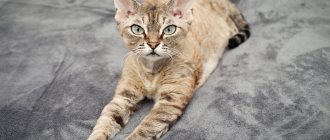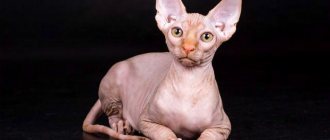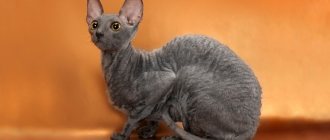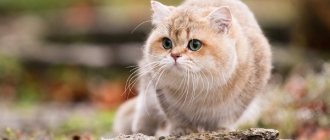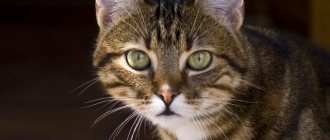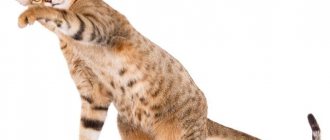Someone will say: “Ugh, what an alien!” - they will pass by and not look back, while others will be attracted by the unusual curly hair, like that of a young lamb, and... a surprisingly piercing gaze. And also the proud look and graceful gait of the queen. Yes, that's what they are - Cornish Rex cats.
No matter how they are treated, it is impossible to forget them. They are unusual and mysterious, although they owe their appearance to chance.
Description of the breed
The unusual-looking cats appeared as a result of a stable genetic mutation. Cats with fur like a sheep have excellent health and are unpretentious in their maintenance. For their protruding ears and external resemblance to their naked counterparts, the Cornish are called astrakhan sphinxes. The Cornish have a twin brother, the Devon Rex, but these breeds are not crossed with each other due to differences in genotype.
Appearance - what does a Cornish Rex look like?
Not too large, elegant and graceful cats with curly hair, large ears, a triangular muzzle and well-developed muscles.
American type
The American Cornish is distinguished from its English-type counterparts by its ovoid head and lighter bone structure.
The muzzle is wedge-shaped, the profile is rounded, the features of the muzzle are clear, the cheekbones are well defined, the stop is moderate or even, the skull is convex. The ears are wide at the base, rounded at the tips, resembling a cone in shape. The ears are set wide apart.
The forehead is rounded, the nose is “Roman”, the chin is courageous. The jaws are strong, with a scissor bite; a straight bite or a slight overshot is allowed. The head is set on a flexible and muscular neck of medium length. The body is slender, elongated, the stomach is tucked. The chest is well defined, looks strong, of moderate width. The long, whip-like tail gradually tapers towards the tip.
Relative to the body, the limbs look rather thin - the legs of the Cornish Rex are distinguished by lightness and thin bones. The paw is small, graceful, gathered in a tight bun. The fingers are long, the pads are shaped like an oval.
European type
“Europeans” differ from “Americans” in having heavier lines - they are less light and graceful, they have more powerful bones and the ovoid shape of the head is not as pronounced as their counterparts of the American type. In general, the differences between the two types are minor.
Size and weight
The height of an adult animal is 23-27 cm. The weight of an adult cat is 3-5.5 kg, cats are more graceful and weigh less than cats - 2-4.5 kg.
Wool
The curly Cornish Sphynx or astrakhan cat has soft and delicate, wavy, spineless fur like astrakhan fur. Cornish Rexes are cats with fur like a sheep's. On the chin, chest and tummy of the Astrakhan Sphynx, the fur is shorter and more curled than on the rest of the body. The Curly Cornish coat has no awn, the fur fits tightly to the body, forming uniform waves that are soft to the touch.
Colors
In addition to the common coat colors - black, white, red, blue, lilac, chocolate, etc., the breed standard allows almost any color. These are all varieties of tortoiseshell color, tabby, intricate torby - the Cornish Rex can have any coat color.
Astrakhan Sphynxes of Siamese color are called “C-Rex”.
Eyes
Large or medium-sized Cornish eyes resemble an oval in shape and look slightly slanted. The pigment of the iris must match the color of the representative of the breed.
Photos of colors
According to breed standards, the color of the Cornish Rex is allowed in all colors and patterns: solid colors, tabby, two-color, tortoiseshell.
Professionals know how to distinguish the breed and type of Cornish Rex from a photo.
Are Cornish Rex cats hypoallergenic or not? How often do they shed?
People who suffer from allergies to cat fur gravitate towards Sphynx cats. Cornish Rex cats are so short-haired that they practically do not shed. It is still necessary to comb the Astrakhan Sphynx from time to time - periodically you need to remove dead short hairs.
Before getting a cat of any breed, allergy sufferers should remember that there are no completely hypoallergenic animals. Allergies can be caused not only by fur floating in the air, but also by pet dander, saliva, and animal waste.
Health and illness
The breed stands out for its good health. Hereditary diseases of the Cornish Rex have bypassed them and have not yet been discovered. As long as you have a balanced diet and vaccination, there should be no problems.
A feature of the breed's organism is its specific sensitivity to anesthesia. Cornish Rexes are more difficult to tolerate anesthesia than other cats. When visiting a veterinary clinic, be sure to remind the doctor about this nuance.
Many people are surprised how long Cornish Rex live. The average life expectancy is 15 years, although the breed is long-lived and cats often live up to 20 years.
Cornish Rex and children
There is no need to be afraid that the cat and lamb will offend the owner’s baby. Owning Astrakhan Sphynxes is recommended for both single people and families with children. The friendly Rex from Cornwall will get along with both a teenager and a stupid child. Before getting a cat with fur like a sheep, you should carry out educational work with children. The child should be explained how it is possible, and most importantly, how not to treat animals.
Cost of kittens
The price of a baby from a cat-lamb depends on factors such as the health of the kitten, the absence of defects, the birth of the parents, the presence of breed characteristics and exhibition titles.
A small Sphynx Rex without documents will cost the owner 5-20 thousand rubles. Buying a Cornish Rex kitten with a pedigree will lighten your pocket by 20-65 thousand rubles.
Tips for choosing a kitten
When choosing a kitten, do not save money by trying to choose an option with a lower cost. All prices are determined by the prestige of the nursery, the quality of the pedigree, the class of conformity to the exterior, the presence of vaccinations or operations performed. Savings can result in the purchase of a sick pet or mixed breed.
Before purchasing, seek a preliminary consultation to get to know the nursery's students and ensure the proper condition of the facility. All Cornish Rex kittens must be active and well-groomed. Do not buy animals with tousled fur, watery eyes and an unpleasant odor from the ears.
The responsible seller is required to draw up a sales contract and hand over breeding documents. Kittens under 2.5 months should not be offered for sale. Through mother's milk, they develop passive immunity, which helps protect against infections until the first vaccine is administered.
Cornish Rex kennels
To be sure that you are purchasing a high-quality animal, it is better to buy kittens in specialized nurseries where Cornish Rex cats are bred.
Here is a small list of names of nurseries engaged in breeding Cornish cats:
- "CORNELIAN" (Moscow)
- “Chocolate Joy” (single-breed cattery for short-haired cats, St. Petersburg);
- "Kornelita" (Moscow);
- "Amadeus" (Kharkov);
- "REXY" (Moscow);
- "REX GRACEFUL" (Moscow).
Care and maintenance
Caring for a short-haired, curly pet is not at all difficult - even a person who has never owned a cat can handle it. The animal should have individual drinking bowls and food bowls, scratching posts, toys, as well as its own personal place in the house where it can rest from the hustle and bustle.
From a young age, the Astrakhan Sphynx should be accustomed to hygienic procedures - trimming claws, washing eyes, cleaning ears and teeth.
It is better to take care of animal hygiene at a time when the pet is in a good mood; in no case should you do it forcibly. To treat the ears, it is advisable to purchase a special lotion; the eyes can be washed with a cotton pad dipped in ordinary boiled water.
If your pet is found to be sour, instead of boiled water you should use either tea leaves or chamomile infusion. If the redness does not go away, or discharge from the eyes does not disappear after treatment, the animal should be shown to a veterinarian.
The oral cavity of cats is treated once a month. To do this, use a special finger attachment and cat toothpaste. If you don’t have a nozzle, it doesn’t matter; you can get by with a sterile bandage wrapped around your finger for these purposes.
What to feed
Due to excessive activity and the lack of long hair, which would help provide the animal with the necessary thermal balance, Cornish cats experience hunger more often than their woolier counterparts. Because of this feature, the Cornish may seem like a glutton, always begging for tidbits.
The owner should not succumb to such provocations from his curly-haired Cornish Sphynx. Dry food should be given within the daily allowance determined by the manufacturer, otherwise excessive food can lead to obesity.
If the owner prefers to feed the pet dry balanced food, breeders recommend at least occasionally diversifying the cat’s diet with natural food.
If the owner wants his cat to eat natural food, products such as lean meat, boiled sea fish, cottage cheese, fermented milk products, cereal porridge, fresh and boiled vegetables are suitable for the Cornish. Many Cornish people love greens and sprouted oats.
The curly-haired Sphynx should not be given fatty foods, bony river fish, flour, sweet, or salty foods. It is also undesirable to give milk to cats; it is better to replace this product with fermented milk products. Prohibition on pork, liver (not digestible), bones, leftovers from the master's table, food with spices and herbs.
Grooming
The curly, delicate fur of the sheep cat is so short that it does not require daily brushing. It is enough to collect short dead hairs from your pet’s astrakhan fur coat a couple of times a week using a comb or a piece of hard terry towel.
Short-haired Cornish cats need to be bathed when they get dirty, but this should be done much more often than their long-haired counterparts. The hairs on their curly coats are too short, so they do not absorb sweat and oil from the pet's skin well. If the Cornish Rex is not bathed on time, it can lead to skin diseases. It is better to wash the fur of a lamb cat using a special shampoo for cats with short hair.
Potential Health Problems
In general, representatives of the Cornish Rex breed are distinguished by good health and high immunity. However, astrakhan cats often have such unpleasant sores as “greasy tail”, metabolic disorders, and retinal atrophy.
Features of feeding and diet
Due to their increased activity, Cornish cats are constantly hungry. Be careful when feeding and follow your veterinarian's recommendations. An increased caloric intake is fraught with obesity and other complications.
For cats with metabolic disorders, veterinarians recommend periodic fasting. Please note that fasting days are carried out under the strict guidance of a doctor and do not always imply a complete refusal of food.
The animal's diet should be natural or dry. Mixing the two types is unacceptable and is fraught with disruption of the gastrointestinal tract. Dry food must be at least super premium. Pay attention to the country of origin. Good reviews are typical for Canadian production, while domestic producers still skimp on the quality of ingredients.
If you are in doubt about what food to feed your pet, consider the main indicators: age, health, general activity and size. Give preference to canned food with pieces of meat, as frequent consumption of dry food overloads the weak digestive system of the Cornish Rex.
Eating natural products requires strict adherence to daily caloric intake. Check with your veterinarian how many times to feed the Cornish to avoid obesity, deficiency or excess of vitamins. Until 1 year of age, focus on calcium, which is necessary for the proper formation of bone structure.
Contrary to popular belief, fish is dangerous for most cats and can cause urolithiasis. You should also avoid liver, which can change the color of the coat. Meat products should account for at least 80% of the diet.
Pros and cons of the breed
The positive aspects of living under the same roof with a Cornish Rex include their affection and friendliness. An active and cheerful curly cat will not let you get bored alone, and by cuddling and purring his tender song in his owner’s ear, he will lift his spirits and lift him out of despondency. A kind of curly antidepressant. The Astrakhan cat is clean, easy to train, and has the ability to perform simple tricks. Cornish cats are easy to litter train and have no odor.
The point about the disadvantages made me think for a long time - it seems that the cat-lamb has no disadvantages. The only minor drawback may be the occasional stubbornness shown by the Cornish people. But a cat’s self-will and presence of its own opinion are a manifestation of its intelligence.
Nutrition
There are no special recommendations for feeding Cornish Rex. Like all cats, the basis of the diet should be meat and a small part of vegetables.
Today, pet stores have a fairly large selection of specialized food of good quality. You can also feed your pet natural (homemade) food, but then you need to include vitamins in the diet.
Once or twice a month you can arrange fasting days, but don’t get carried away; cats, unlike dogs, are harmful to fasting.
Fasting days for cats do not have to exclude food completely, just slightly reduce the dosage of food on these days.
History of the breed
Curly-haired cats were bred quite recently - the Cornish Rex breed appeared in 1983. The story of the curly foundling began in the 50s of the last century in Great Britain. On one of the English farms, an extremely large-eared kitten with unusual curly fur was born. The long-eared curly cat was named Kalinbuker. An unusual-looking mutant was born at a difficult time for people; the British had no time for breeding cats at that time. They even wanted to castrate poor Kalinbooker, but somehow this didn’t work out, fortunately for lovers of the Cornish Rex breed. After listening to the advice of a veterinarian, the owner of the infernal kitten, Nina Ennismore, decided to match the lamb-like Kalin with his completely ordinary, smooth-haired mother. The result was surprising - the litter included both smooth-haired and curly-haired kittens.
Then the unusual curly cats came to the United States, and American felinologists began breeding. Breeding the Astrakhan Rex lasted for 30 long years, but now cat lovers have the pleasure of keeping a curly “alien miracle” in their home.
Breeding Basics
Puberty in representatives of the breed occurs closer to 7–9 months, but at this time the animal is not yet ready, either mentally or physically, for the first mating. Therefore, it is necessary to look for a suitable partner closer to the pet reaching one year of age, when the cat is already able to bear and give birth to healthy offspring without physical abnormalities.
Pregnancy in pets lasts from 63 to 66 days and, as a rule, proceeds normally, but much depends on the health of the expectant mother. Sometimes vitamin supplements or medications may be needed to make her feel better. It is not recommended to knit a cat too often (about twice a year). Childbirth and feeding of offspring exhausts the animal, leading to various diseases and stress.
Crossing nuances:
- when choosing a bride or groom, you should evaluate their health: check for vaccinations, examine the animal for treatment against fleas and worms, ask the owner for a certificate of absence of infectious diseases;
- one of the partners must be previously untied, only in this way the process will be crowned with success;
- the crossed individuals should not be closely related;
- vaccinations must be done about a month before mating; vaccination on the eve of mating can lead to abnormalities in the offspring;
- the pet should be left next to the male for a period of 3 to 6 days, usually fertilization occurs on the 4-5th day with a seven-day duration of estrus;
- both partners must first trim their claws to avoid injury;
- Mating should be carried out on the territory of the male.
It should be noted that breeding Cornish Rexes with representatives of other breeds is strictly prohibited. Such a union can provoke the birth of unhealthy and non-viable offspring.
Interesting facts about Cornish Rex cats
- What is the difference between a Cornish Rex and a Devon Rex? Why is it impossible to breed representatives of these outwardly similar breeds?
Representatives of the Devon Rex and Cornish Rex breeds are not crossed due to differences in the genotype; they do not have common relatives.
- Why does the astrakhan cat eat so much?
The Corniches were known as gluttons due to the fact that they were constantly haunted by a feeling of hunger. This occurs because lamb cats are extremely active. Plus, their fur is too short to properly maintain body heat balance. Therefore, curly-haired cats are always not averse to eating in order to gain strength or warm their bodies.
- Why does a lamb cat have claws visible?
One of the peculiarities of the breed is the fact that Cornish cats do not know how to completely hide their claws, like other cats. Therefore, the Cornish Rex's claws are always visible.
- Will a Cornish get along with a dog?
Yes, easily! Moreover, the Cornish man and the dog will become friends. But whether the friendship between a dog and a Cornish Rex will be strong, without offense, will depend on the behavior of the owner. To ensure that the curly-haired cat does not have any grudges against the dog, the owner of the animals must pay more attention to the Cornish than to the dog. Otherwise, the cat-lamb will be offended - if the owner’s attention is divided fairly, that is, in half, then the Cornish will be jealous of the owner of the other pet. A cat-lamb will be friends with a dog only if it receives more attention than the second pet.
Key facts
The name of the breed comes from the county of Cornwall, located in the southwest of England, and the curly-haired rabbit of the rare Astrex breed. The country of origin of the Cornish Rex is recognized as Great Britain, where the first selection work to develop a new breed began.
Description of the Root Rex breed includes size standards. The weight of the Cornish is from 3 to 5 kg and depends on gender. Maximum sizes are typical for males. The average life expectancy of the Cornish Rex is from 14 to 16 years and is explained by a strong immune system and the absence of specific diseases transmitted at the genetic level.
The breed is distinguished by its curly coat, which is obtained by inheriting the recessive “rex” gene. The wavy curls covering the entire body of the animal resemble velvet. The aristocracy of graceful proportions is combined with developed body muscles; harmony is a key characteristic of the Cornish Rex in terms of appearance.
Cornish Rex are excellent jumpers, able to climb any elevated surface. These monkey habits often end in tragedy for vases or other fragile dishes, so experienced owners are advised to think through the entire storage system in advance.
Among the disadvantages of the breed, breeders note increased talkativeness. Undoubtedly, most cat lovers will count it as a plus, but sometimes the cat becomes too annoying. Keeping with other animals does not always help to redirect the pet’s increased attention, since the Cornish’s main interest is the owner.
If you are ready to devote most of your time to a cat, and the possibility of close contact with the animal is your main priority, then don’t even think about it. The curly-haired pet will quickly settle down on your lap and will gladly support any dialogue with funny and varied sounds.
Photo
Owner reviews
The owners of Astrakhan cats say that there is no better pet than a therapy cat. The favorite thing of curly-haired healers is a massage, given with love to the owner and his family members. Sheep cats love to gently knead their owner's body with their paws, and bite and lick the hands of a person they trust. This is how the Cornish Rex expresses its love and devotion. Cornish cats are praised for their cleanliness - they are easy to litter train. Curly-haired cats are extremely smart and easy to train.
Character, intelligence and temperament
Reviews from numerous owners of curly-haired cats and cats definitely agree on one thing: these are one of the smartest pets. Intellectual cats are about them.
They are not one of those cats that keep to themselves and “walk on their own, but on the contrary, they become very attached to the owner and become his true friend. Having no habit of marking territory, taking revenge or stealing, they are deservedly considered to have an ideal cat character.
With all this, you can walk with them, visit exhibitions - they calmly react to such changes in the situation, especially if they are accustomed to going out into the world from kitten age.
